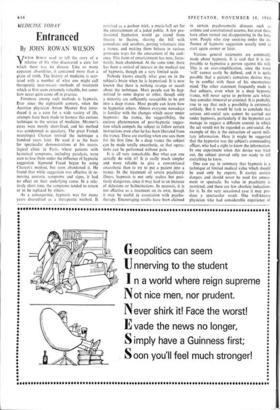As a consequence, hypnosis was for many years discredited as
a therapeutic method. It •
• •
• • • • • • • • • • • • • • • •
• id/ • • •
• • • • • • • •
•
• • • • • • • • • • •
• • •
•
• • • • • •
survived as a parlour trick, a music-hall act for the entertainment of a jaded public. A few pro- fessional hypnotists would go round from theatre to theatre, sharing the bill with comedians and acrobats, putting volunteers into a trance, and making them behave in various grotesque ways for the amusement of the audi- ence. This form of entertainment has now, fortu- nately, been abandoned. At the same time, there has been a revival of interest in the medical use of hypnosis, though on a very limited scale.
Nobody knows exactly what goes on in the subject's brain when he is hypnotised. It is now known that there is nothing strange or occult about the technique. Most people can be hyp- notised to some degree or other, though only a minority are sufficiently susceptible to be put into a deep trance. Most people can learn how to hypnotise others. Almost everyone nowadays is familiar with the changes which occur under hypnosis : the trance, the suggestibility, the curious phenomenon of post-hypnotic sugges- tion which compels the subject to follow certain instructions even after he has been liberated from the trance. These are startling when one sees them for the first time. In a deep trance the subject can be made totally anaesthetic, so that opera- tions can be performed without pain.
It is all very remarkable. But what can one actually do with it? It is really much simpler and more reliable to give a conventional anaesthetic than to try to put a patient into a trance. In the treatment of severe psychiatric illness, hypnosis is not only useless but posi- tively dangerous, since it may lead to an increase of delusions or hallucinations. In neurosis, it is not effective as a treatment on its own, though it may be useful in association with psycho- therapy. Encouraging results have been claimed






























 Previous page
Previous page